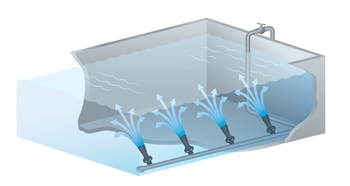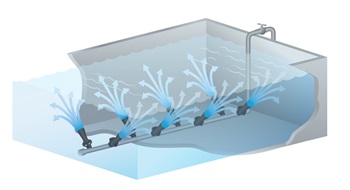Fluid mixing and agitation
In many process lines where tanks of chemicals are used, it is necessary to keep the fluid in the tank in motion to avoid separation and sedimentation. Alternatively, different fluids may need to be mixed or blended. In either case, fluids can be recirculated around the tank to achieve this. A simple recirculation process can greatly be enhanced by the introduction of either eductor nozzles or rotary mixing nozzles.
How eductors work
 The fluid is recirculated through the eductor but due to the shape of the nozzle as the fluid is ejected it creates a pressure drop which serves to suck in the surrounding fluid (the venturi principle). This means that 5 times the volume of pumped fluid is set in motion in the tank.
The fluid is recirculated through the eductor but due to the shape of the nozzle as the fluid is ejected it creates a pressure drop which serves to suck in the surrounding fluid (the venturi principle). This means that 5 times the volume of pumped fluid is set in motion in the tank.
 The eductor is submerged inside the tank. Motive liquid is pumped under pressure through the discharge orifice. The jet of motive liquid enters the venturi section, entraining additional liquid from the tank and moving it through the venturi. A discharge plume of combined motive and entrained liquid exits the venturi and continues the mixing and agitating action for a substantial distance. The operation of the eductor creates a multiplying effect on fluid flow. Depending on the model and the operating pressure, the volume of liquid discharged from the eductor will be 4 - 5 times greater than the volume of motive fluid pumped. This highly efficient operation reduces energy use and saves you money.
The eductor is submerged inside the tank. Motive liquid is pumped under pressure through the discharge orifice. The jet of motive liquid enters the venturi section, entraining additional liquid from the tank and moving it through the venturi. A discharge plume of combined motive and entrained liquid exits the venturi and continues the mixing and agitating action for a substantial distance. The operation of the eductor creates a multiplying effect on fluid flow. Depending on the model and the operating pressure, the volume of liquid discharged from the eductor will be 4 - 5 times greater than the volume of motive fluid pumped. This highly efficient operation reduces energy use and saves you money.
Using eductors will reduce settling of suspended solids, improve circulation, maintain uniform
liquid characteristics, mix chemicals, or move solids along the bottom of a tank. Eductors offer a lightweight, inexpensive alternative to mechanical mixing methods.
How rotary mixers work
Rotary mixing jets work in the same way as rotary tank cleaners work; indeed, they are essentially the same machine. Fluid from the tank is recirculated through the submerged jet cleaner. Alternatively, the fluid that is to be mixed into the liquid already in the tank is pumped through the rotary mixer.
This creates powerful jets of fluid which rotate around in two dimensions. The jets are brought to bear on each part of the tank over a set mixing cycle. Over the cycle complete mixing will occur.
As a bonus, after the mixing cycle and when the tank is emptied, the rotary mixer can be used as a powerful tank cleaning head. The supply fluid is simply swapped to whatever CIP wash fluid is used and the mixer now becomes a rotary jet tank cleaner.
Applications
Eductors may be employed effectively in tanks used for plating, phosphating, sludge, paint, anodizing, agricultural fertilizers and chemicals, pulp, slurries, electrocoating and pretreatment. TurboMixTM nozzles are commonly used in open tank heating applications. Heating is accomplished by introducing steam into an open tank through the submerged educator. Some common applications for open tank heating are cooking grain, cooking mash, cooking starch, heating, as well as circulating and mixing.
We supply two ranges of edcutor systems. For eductors in metals (brass, cast iron and stainless) we supply the Turbomix system from BETE, for plastic eductors in PP or PVDF we supply the Uni Eductor from Uni-Spray which is part of their quick fit system for pre-treatment spray lines.
Please access the data sheets by clicking on the icons below.